Find out how cycling clothing can transform your comfort and performance on the bike. Here’s everything you need to know to avoid being under- or overdressed the next time you go for a ride.
As a beginner, knowing how to dress when going for a ride usually involves a lengthy trial and error period.
Many novel cyclists even believe that cycling-specific apparel is a marketing ploy… until they give them a try.
Of course, if you only ride a few miles to the store or along local bike paths, riding in casual clothes is perfectly fine. On longer and more frequent rides than that, you’re bound to suffer the wrath of saddle sores, sweaty back, and unpleasant chafing.
In this guide, we’ll explain why cycling clothing matters and how to buy exactly what you need based on your style of riding, weather, and personal requirements.
Contents
- Why Choose Cycling Specific Clothing?
- Cycling Clothing by Discipline
- A Guide to Most Common Cycling Apparel
- Men’s vs. Women’s Cycling Clothing
- Winter Cycling Apparel
- Chamois (Padding) Explained
- Quality Classes of Cycling Clothing
- Cycling Clothing Sizing
- How Much Should I Pay for Cycling Clothes?
- Where to Buy Cycling Clothes
- FAQ
- Final Thoughts
Why Choose Cycling Specific Clothing?
The answer to this question is quite simple. However, the devil is in the details. It is easy to say that cycling-specific clothing should be chosen purely because it is designed for biking. This is a completely fair statement, but in order to know what bike gear you should choose, you need to know about the materials, fit, padding, and other features that the piece of clothing has.
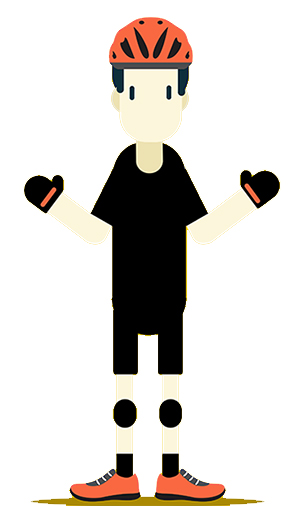 Let me use an example to make this clear:
Let me use an example to make this clear:
Rob is a cross-country mountain biker looking for a pair of shorts. He decided that he wants to stay away from the form-fitting lycra style, so he starts looking at looser-fit mountain bike shorts. Rob sees a pair that he likes and buys them. On his next ride, Rob notices that he is getting saddle sores from all the pedaling.
What was Rob’s mistake?
He bought shorts designed for downhill mountain biking without realizing it. These usually lack a chamois pad because they are designed for riding almost entirely standing up.
That was just a simple example that makes you think about why it is important to make an informed buying purchase. If Rob had known he should be getting specific shorts for cross country (not DH ones), he probably would’ve ended up with a chamois pad and as a result, would’ve been less sore after his rides.
So the main reason to choose bike clothing is to make your rides more enjoyable and improve performance.
You will also find that cycling clothing as a whole breathes better than normal clothing thanks to the use of specifically chosen synthetic materials. Bike gear designed for road riding and similar disciplines is also very aerodynamic.
For a limited time:
Cycling Clothing by Discipline
When you think about the type of riding you do, a certain style of clothing probably comes to mind. That is because apparel for different cycling disciplines is designed to solve different problems inherent to that discipline.
Note that all bike gear should be highly breathable. Breathable materials allow perspiration to evaporate which cools your down and keeps you dry.
Below is a comprehensive guide to cycling apparel based on the type of cycling you do. Know exactly what to wear for road, enduro, trail, downhill, and other types of riding.
Road Riding / Hybrid / Cross-Country Cycling Clothing
These styles of riding involve a lot of seated pedaling. Since the biggest factor on these types of rides is efficiency, you will likely want something tight-fitting. Almost all clothing designed for these cycling disciplines is made of lycra or spandex (or a combination of other materials).
Here is what you should be looking for in the most common clothing items found in the road and cross-country biking worlds:
Cycling Jersey:
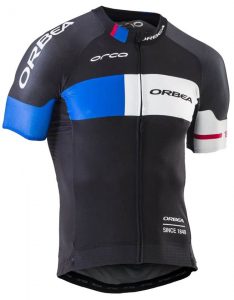 A road-style cycling jersey should be tight-fitting.
A road-style cycling jersey should be tight-fitting.- It should also feature a zip on the front that runs down the entire length of the jersey. The zip can be opened when riding to help keep you cool.
- Another feature of a good jersey is a stand-up collar to help shade your neck when in the bent-over riding position.
- Road cycling jerseys usually have three rear pockets for carrying essentials.
- The jersey should also be longer in the back to ensure full coverage when riding in the drops.
- Finally, you probably want reflective detailing to make it easier for cars to see you (obviously not as important when riding cross-country).
Bibs and Shorts:
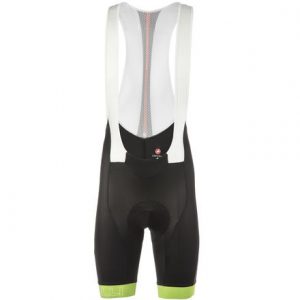 Road shorts should be tight-fitting for good aerodynamics and so that they don’t move around.
Road shorts should be tight-fitting for good aerodynamics and so that they don’t move around.- The shorts should be made of multiple panels (usually 6 to 8).
- A chamois pad is a must in order to prevent saddle sores.
- Many shorts will feature reflective detailing as a safety feature.
- Shorts used in road and XC should of course also enable free movement so elasticity is key.
- Comfortable leg grips will also be included in good shorts to stop them from sliding up.
- Bib shorts also have shoulder straps that keep the shorts up and prevent the chamois to move around.
Trail / Enduro Cycling Clothing

Trail and enduro mountain biking involve riding rough trails that include climbs, descents, and sometimes features such as jumps or drops. This means that there is a good amount of both seated and stand-up riding.
Such rough terrain also demands extra-durable gear as you don’t want it to be destroyed after your first crash. The style of clothing trail riders usually go for is looser fitting and more casual looking than road bike clothing.
Here are some features that quality trail/enduro bike gear makes use of:
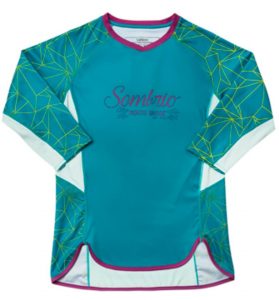 Jersey:
Jersey:
- Some will feature a small pocket for ID or lift passes.
- Both long- and short-sleeve models exist.
- The best ones will be made from materials with antibacterial properties to help with the sweat.
- The back of the cycling jersey should be a bit longer than the front to ensure full coverage.
- They should feel light and comfortable, providing ample room for movement.
- MTB jerseys fit loosely because aerodynamics are not as important as in road cycling.
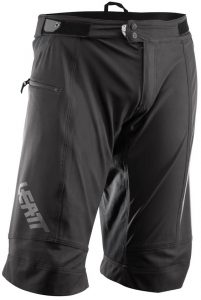 Shorts:
Shorts:
- The best enduro and trail shorts should feel light and allow for free movement, which is why they fit loosely.
- They should be designed to work with knee pads. The best trail shorts will not interfere with the pads when riding. Some have slippery material at the bottom of the short’s legs to help with this.
- They usually feature zipper pockets to carry keys, energy bars, a smartphone, etc.
- Many shorts will also include a chamois pad of some kind which may or may not be removable.
- Ventilation panels will also be included in many high-quality MTB shorts.
Downhill Cycling Clothing
 Downhill mountain biking is seen as an extreme form of cycling. It requires a lot of standing up and a little seated pedaling. Since downhill mountain biking involves riding the roughest terrain, the gear must also be able to take the abuse. The best comparison for downhill gear is what you would find in motocross. It is baggy and about as durable as cycling gear comes.
Downhill mountain biking is seen as an extreme form of cycling. It requires a lot of standing up and a little seated pedaling. Since downhill mountain biking involves riding the roughest terrain, the gear must also be able to take the abuse. The best comparison for downhill gear is what you would find in motocross. It is baggy and about as durable as cycling gear comes.
Here is what you should look for in downhill mountain bike gear.
Jersey:
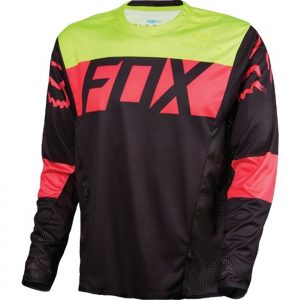 The jersey will almost always be long-sleeved to help minimize scrapes when crashing.
The jersey will almost always be long-sleeved to help minimize scrapes when crashing.- It should be lightweight, with firm cuffs to help the sleeves stay in place.
- There are usually no pockets on a downhill cycling jersey as DH routes are relatively short.
- Flat seams should be included to prevent rubbing.
- The jersey should be made of very durable and breathable fabric.
Shorts:
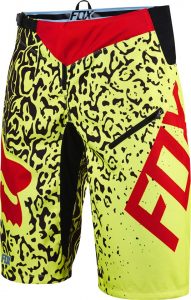 Downhill shorts are typically heavier than trail shorts but hold up better to crashes.
Downhill shorts are typically heavier than trail shorts but hold up better to crashes.- There is sometimes a pocket included, which is always nice to have in order to carry necessities.
- Downhill shorts lack the chamois padding that most cycling shorts have because you do not really sit down a lot when riding downhill.
- Good downhill mountain bike shorts will not interfere with knee pads. Look for a slippery fabric on the cuffs that allows the shorts to slide over the pad.
Pants:
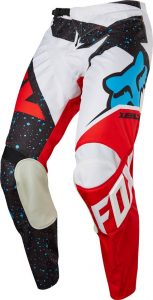 Downhill cycling pants offer more protection for your legs than shorts. They may look like motocross pants, but they are usually a bit longer since you don’t wear boots when mountain biking.
Downhill cycling pants offer more protection for your legs than shorts. They may look like motocross pants, but they are usually a bit longer since you don’t wear boots when mountain biking.- Bike pants should have plenty of room for knee pads to fit underneath and allow for comfortable pedaling.
- The best downhill pants will have a fair amount of venting to keep your legs cool while riding.
- Most importantly, cycling pants should be very durable as they will likely be put through a lot of abuse.
As an extra: Best MTB Shoes
A Guide to Most Common Cycling Apparel
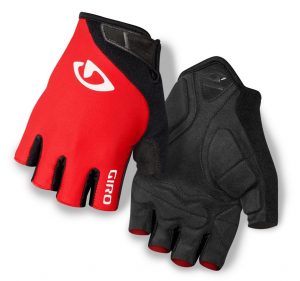
Cycling Gloves
No matter what type of cycling you do, cycling gloves are always a good option to help prevent blisters, calluses, and sore hands.
In the summer, road and XC riders use fingerless bike gloves, whereas other forms of mountain biking almost always involve full-finger gloves. Here are features that may be included in the design of the two main styles of cycling gloves.
Road / XC / Hybrid Cycling Gloves
- Usually short-fingered bike gloves (long-fingered are available for colder days)
- Have gel or similar padding where the hands make contact with the handlebars
- Extremely ventilated and lightweight material
- Leather (or similar) on palms for durability
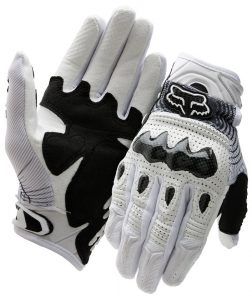 Mountain Bike Gloves
Mountain Bike Gloves
- Usually full-fingered
- Durable fabric that helps with abrasion in case of a crash
- Leather (or similar) on palms for longevity
- Provide grip over sweaty hands
- Some feature knuckle padding for protection
- Similar to motocross gloves
See More: Best Cycling Gloves
Cycling Jackets
Cycling jackets are used for two main reasons. To stay warm, and to stay dry. That being said, there is a lot to consider when buying a jacket specifically for cycling.
Firstly, cycling jackets can be found in a variety of fits. Choose a fit that is similar to the other articles of riding gear you have. For example, a road cyclist should probably get a relatively tight-fitting jacket to stay aerodynamic, whereas an enduro rider probably cares less about that.
Make sure the jacket is extremely breathable. The last thing you want is to turn the inside of the jacket into a sauna. Zippers and vents will also help with this so keep them in mind!
Jackets for cycling will be a bit longer at the back, this is to ensure full coverage when riding in the drops.
Again, pick something for the climate you are riding in. If it is very cold, buy a heavier jacket and vice versa.
Read more: Best Cycling Jerseys
Long Sleeve Apparel vs. Arm/Leg warmers
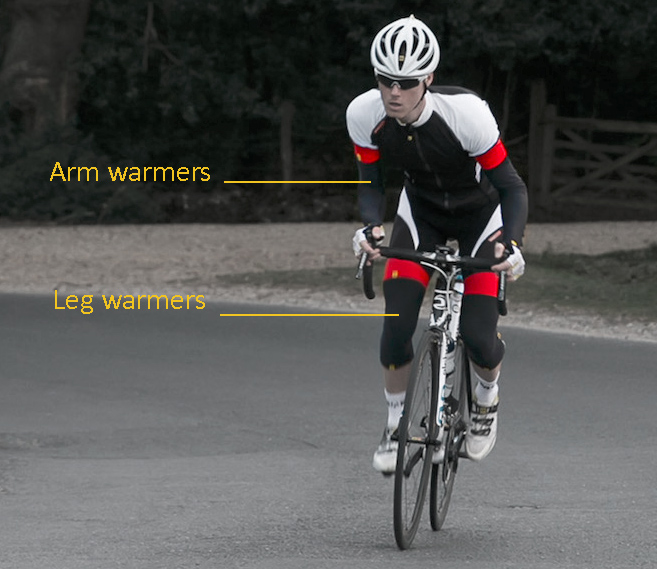 This is where a quite common debate comes in. Should I buy full-length cycling clothing for colder days, or should I just buy arm and leg warmers and wear them as needed?
This is where a quite common debate comes in. Should I buy full-length cycling clothing for colder days, or should I just buy arm and leg warmers and wear them as needed?
The answer may change a bit from person to person but there are a couple of key facts that cyclists should consider.
Arm and leg warmers are great because they are so easy to take on and off. This makes them useful for more than just winter rides, such as at the start of a ride on a cool morning or any other time the weather takes a turn.
The warmers can also have benefits such as water resistance and UV protection that you obviously wouldn’t have if you didn’t wear them.
Another great thing about warmers is that it is easy to get them to cover your whole arm. All too often riders buy long cycling jerseys that look like they have the right length sleeves, but then they find out the sleeves are too short when they start riding. This isn’t really a worry with arm or leg warmers.
Lastly, people choose warmers over longer-length riding gear because, for the most part, they are more comfortable. Bike clothing is mostly about comfort anyways.
Men’s vs. Women’s Cycling Clothing
It is clear that women have different body anatomy than men. However, many bicycle clothing companies are still offering unisex clothing. I would strongly recommend ignoring those unisex options and getting clothing specifically for your gender instead.
Men’s cycling clothing will be sized following guides more similar to everyday men’s clothing. Whereas women’s cycling clothing will be of course sized following everyday women’s sizing.
The biggest difference between men’s cycling gear and women’s will be found in the shorts chamois pad. Since males and females have such different anatomy, support must be provided in different places. A female wearing male shorts will not receive the support that will be most comfortable for her.
Many cycling apparel companies are still offering unisex clothing
The other way in which the clothing differs is the cut. Women’s clothing is wider around the hips, whereas men’s cycling gear is wider around the shoulder and back.
The actual aesthetics of lots of bike clothing will be different between male and female lines as well.
Winter Cycling Apparel
 Cycling in the winter can mean a lot of different things to different people depending on where you live geographically.
Cycling in the winter can mean a lot of different things to different people depending on where you live geographically.
Although, no matter where you live, winter is always colder than the summer. As a result, a cyclist will have to make some clothing changes to ensure they stay warm when out for a ride.
Start by taking care of your extremities. Since the first part of your body to get cold will naturally be your hands and feet, it is important to take great care.
Buy insulated cycling gloves designed for winter cycling. These will still be comfortable to hold handlebars with (unlike most winter bike gloves) and should breathe well. You will also want to look into winter cycling shoes, shoe covers, and even warmer socks to keep your feet from getting cold.
Related: Best Cycling Socks
Since the first part of your body to get cold will naturally be your hands and feet, it is important to take great care.
The next most important thing to remember when cycling in winter is to wear lots of layers. That allows you to add or remove layers depending on how warm or cold you feel. This will help prevent sweating which could result in wet gear and later, a cold rider. Ride with moisture-wicking base layers and other clothing over it depending on the temperature.
There are plenty of clothing articles designed specifically for winter cycling so take a look at them and decide what you need based on the climate in your area.
See More: Best Winter Cycling Gear
Chamois (Padding) Explained
 When it comes to cycling clothing, you will hear the words chamois or padding mentioned a lot. In cycling, this is the pad that is found in most shorts that provides you with cushioning against saddle sores and chaffing that the bike seat can cause.
When it comes to cycling clothing, you will hear the words chamois or padding mentioned a lot. In cycling, this is the pad that is found in most shorts that provides you with cushioning against saddle sores and chaffing that the bike seat can cause.
When buying cycling shorts, look for some with the best possible chamois because it makes a huge difference in the comfort of your ride. You can also apply chamois cream that also helps with friction.
Shorts with a chamois should be worn on naked skin, without underwear, so that it can do its job in stopping friction around the body’s most sensitive area.
A chamois should fit snuggly and not move around when you wear it. There are also many different thicknesses and materials when talking about chamois. What you choose will be based on personal preference. Most people like padding that is not very thick, but not too thin either. There is a sweet spot in the middle that many manufacturing companies have mastered so if you’re not sure what to get, start there.
Related: Best Cycling Shorts and Bibs
Quality Classes of Cycling Clothing
Although most companies do not mark it on their products, there tend to be three main quality classes to consider when buying bike clothing. The classes are basic, pro, and elite, and they go up in quality and pricing in that order.
Here is what to expect and look for in each category.
Basic
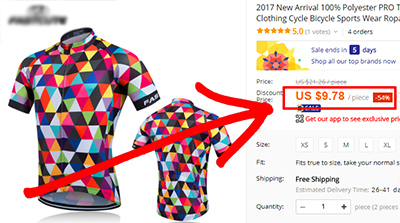
Basic level cycling clothing, often marketed as “entry-level” is the lowest quality of bicycle clothing out there. The products are made to be as cheap as possible and as a result, many corners are cut when it comes to design features and material make-up. You can easily get these online for $10-$20 per piece.
Starting with fit, you shouldn’t expect much. The fit of basic level cycling clothing is usually quite poor. When you lean forward the cycling jersey might lift up and the sleeves will feel awkward too.
Breathability is something that I’ve mentioned a lot because it is extremely important for riders to stay dry and cool. Unfortunately, basic-level cycling apparel is often made of cheap materials that will not benefit the rider. You might as well wear everyday clothes.
Durability is the final thing to mention with basic level clothing because quite frankly, they aren’t durable at all. The clothing will wear and tear quickly and the colors will fade.
So overall, it is recommended that you stay away from basic level clothing, the price may lure you in, but the quality will surely have you running away.
Pro
This is the quality range that’s suitable for recreational riders. Pro-quality cycling gear is usually well thought out and nicely designed. The price is still lower than the elite range which shows that the highest quality materials are not used here. However, the features and fit usually trickle down from the companies’ elite line-ups.
The fit is quite good in this category of cycling clothing. You will notice key design features (such as the placements of elastic materials) that make the clothes hug the body in all the right places. You will also feel like you have a good range of movement in these clothes.
Vents, high-quality zippers (YKK, etc), and innovative materials are all used in the pro level of cycling apparel to ensure breathability. You shouldn’t find perspiration to be a problem in this clothing, as the material should allow it to evaporate.
The pro-level of clothing is also quite durable for the most part. Better inks will have been used for the design, and better seams will increase the strength and comfort of the clothing.
Buy pro level if you are an occasional rider, beginner, or just take part in cycling for fun and not as seriously as a racer.
Elite
Elite-level cycling clothing is the best of the best. In road riding, this is the type of riding gear that you would see a cyclist wearing in the Tour De France.
The fit of elite-level clothing is often designed with input from top athletes in the industry. So there is no doubt that it will be some of the best-fitting bike clothing you will wear. For tighter-fitting styles, elite level is also the most aerodynamic cycling apparel.
The material make-up consists of multiple different fabrics to ensure the ultimate breathability. It often lacks zippers to save weight and stay aerodynamic. The seams will be flat and there will likely be less of them than on cheaper models of riding gear.
Elite-level bicycle clothing is also very durable. This is again thanks to the material makeup, the dyes used, and intense product development.
Overall, the elite level is the best you can get. If you are a serious cyclist, buy elite-level clothing and you will never look back.
Cycling Clothing Sizing
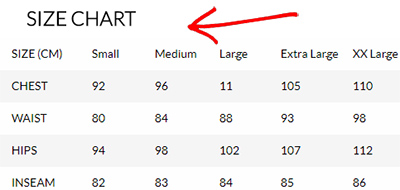
Different brands have different size charts, so it’s important to take a close look at the measurements before ordering.
One company’s medium may be another’s large. It is always best to read a sizing chart when buying online or try the clothing on if buying in person.
Tall, slim people looking to get tight-fitting cycling clothing often have issues finding clothing that fits because it is either too short or too baggy. No matter your body type, there is bike clothing out there that will fit you.
For example, those tall, slim people should look at the company Rapha as they make long versions of some of their cycling apparel. If you put in the research time, you will no doubt find a brand that makes riding gear that fits your body type.
A great thing to look at is reviews when it comes to sizing because someone will usually mention the fit somewhere in there which will give you a good idea as to if it is what you are looking for.
How Much Should I Pay for Cycling Clothes?
If there was only one thing I could say when it comes to buying bicycle clothing, it would be “don’t look at the price, and you won’t likely have to look for cycling clothing again for a few years”. It is quite a simple point really.
If you buy cheap stuff, you won’t like how it feels, and it won’t hold up to much abuse. It is better to make a solid investment that will keep you happy and on the bike for years (depending on how often you ride).
Above, I described the different quality categories of cycling outfits, pick the one that’s right for you, and then shop around. You will, for the most part, see that companies are pretty on par with each other when it comes down to price vs. quality.
“Don’t look at the price, and you won’t likely have to look for cycling clothing again for a few years”.
Of course, do not over-extend yourself. There is no need for you to buy elite-level clothing if you are just a beginner. Just stay away from the basic level of riding gear and you will make yourself happy.
Once you own the desired piece it’s always good to know how to take care of cycling clothes (washing-wise).
Where to Buy Cycling Clothes
If you have read through this article, you should be feeling quite confident about the type of cycling clothing you want, and the level that you intend on buying. Now it just boils down to where to buy it.
You can always visit your local bike shop to see what they have. It is great to support your local economy and you may have a chance to try on some clothing. However, the downside is that their selection may be quite small.
Your other option is to look online. All of a sudden, a sea of choices becomes available for purchase so now you need to narrow down what you want and where to buy it.
Related: Best Shops
I recommend any of these retailers as they are all quite reputable:
FAQ
Is cycling clothing necessary?
Cycling clothing is not necessary for casual riding and short commutes, but it can’t do any harm. However, on longer and more frequent riders, cycling outfits are absolutely essential. Riding without bib shorts will cause saddle sores and riding in a cotton shirt will make you sweat a lot more.
What is the purpose of cycling clothing?
The purpose of cycling apparel is to improve comfort and performance while riding. Cycling-specific apparel is made from synthetic materials that breathe well, wick sweat and allow it to evaporate, and enable free movement. Chamois also prevents saddle sores and improves pedaling performance.
Why do cyclists wear tight clothes?
Cyclists wear tight-fitting clothes to improve aerodynamics and ride faster with less effort. Loose clothes increase air drag and slow the cyclist down, which is why tight-fitting lycra is a must. Such clothes also allow for easier movement and prevent the clothes from ending up in moving parts.
Do you wear shorts over cycling tights?
If you don’t like the idea of walking around in tight lycra shorts, you can wear loose-fitting shorts over them. Just make sure there are no rough seams over the chamois that could cause rubbing and saddle sores. Mountain bikers usually wear loose shorts or cycling pants over padded shorts.
Why do cyclists wear spandex?
Cyclists wear spandex in order to improve aerodynamics and because loose-fitting clothes could get caught up in moving parts, such as the drivetrain. Loose clothes increase air drag around the body which slows the cyclist down. With spandex, you can go faster with less effort.
Is Cotton good for cycling?
Cotton is not a great material for cycling clothing because it retains moisture. A cotton T-shirt will need a lot more time to dry compared to a polyester jersey, which is why the latter is preferred among cyclists. For the same reason, cotton can start smelling bad much faster than polyester.
What should you not wear when cycling?
A few things to avoid wearing when cycling is cotton and very thick pieces of clothing, no matter how cold it is outside. Cotton should be avoided because it retains moisture, whereas a few thin layers of clothing are much better than one thick because it’s easier to take them off and control your temperature.
How tight should cycling clothes be?
Cycling clothes should fit tight around your body. This way, you will get maximum aero gains. However, your kit should not be too tight so as to limit your movement or cause discomfort. Very tight cycling outfits can lead to chafing, blisters, and sores, which is the opposite you want to achieve.
What is the best fabric for a cycling jersey?
Polyester is the best type of fabric for a cycling jersey, combined with nylon, elastane, and spandex. These materials provide excellent breathability, don’t retain moisture, and wick sweat away from the body. Moreover, many polyester materials have antibacterial properties so they prevent foul smells on long rides.
What is the best material for cycling shorts?
Spandex is the best material for cycling shorts. This is a type of synthetic material that has good elasticity, excellent breathability, and low moisture retention. It wraps tightly around the body to improve aerodynamics and dries easily after getting wet.
Final Thoughts
There is a lot to think about when it comes down to buying cycling clothing. You need to know what discipline requires what product. You need to think about the quality classes and the level of riding that you are currently at.
Knowing your body and body type is essential too. You need to think about the changes of season and what clothing changes will be required. Our hope is that this guide gave you some great input on all of these considerations and many more.
Remember that there are thousands of articles of clothing out there designed specifically for cycling.
Do not just rush into a purchase because there is a sale or you like the looks. Do your research, read reviews, and then buy the best cycling clothing for you personally.

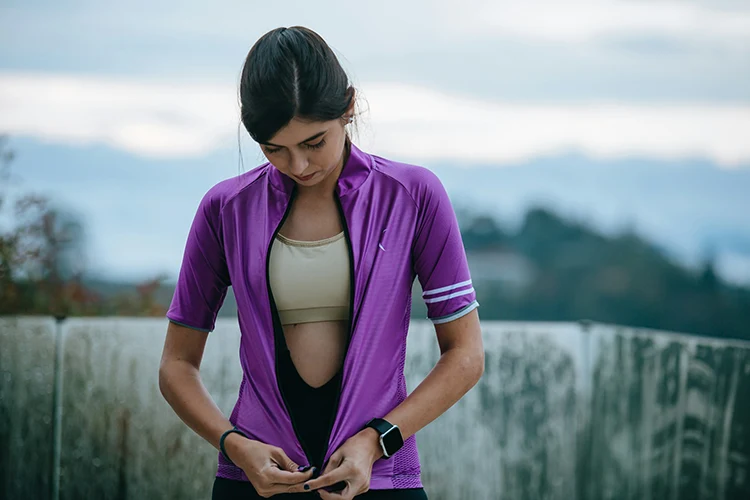

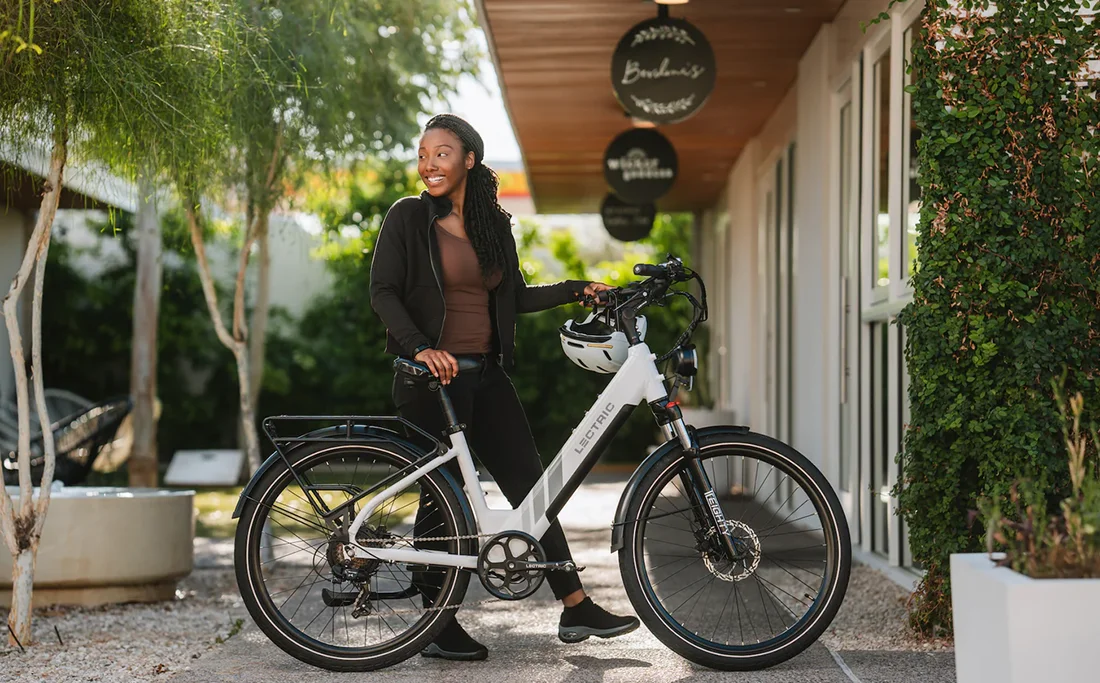
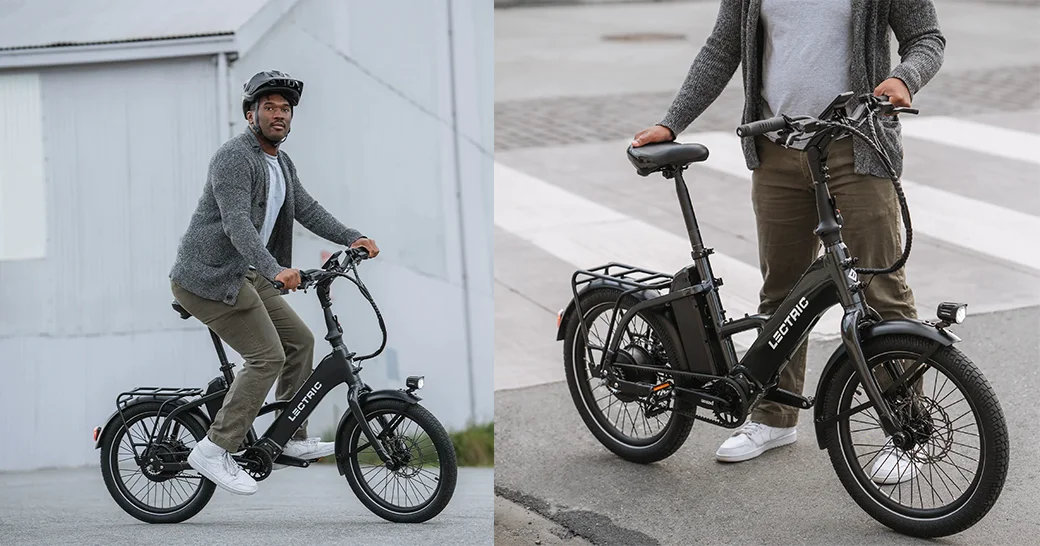
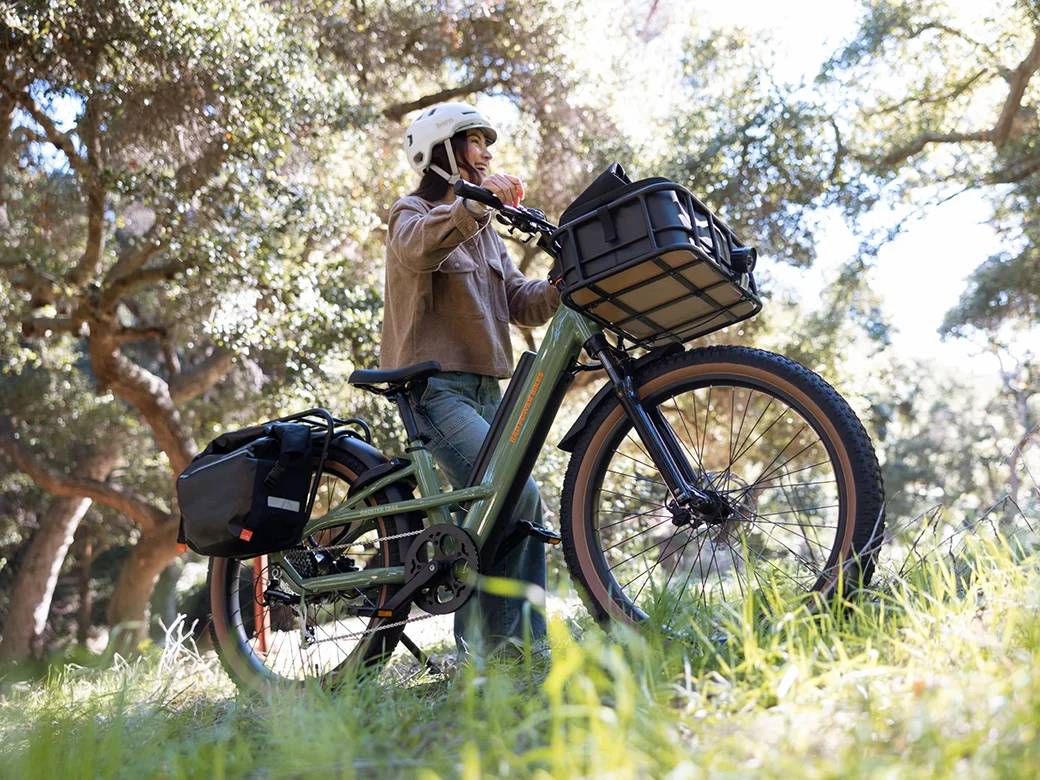
Thanks for explaining how to choose the right cycling clothes for you. The cycling gear that you need highly depends on what type of rider you are and what discipline you are into. Bike tourists are wearing comfortable dri-fit clothing, while triathletes are required to have skinsuits to utilize the technology of aerodynamics. The other day, my friend who is new to cycling asked me what type of gear does he have to buy because he wanted to look good on the road. I recommend he buys a bib set because he is into road cycling. Thanks to this article, I will surely tell him about the proper cycling gear and ask him to go to a local bike shop for more information about the specific gear that he wants.
This information about cycling clothing is very useful for me and those people who Love cycling.
Hi Rizwan,
Thanks for the feedback. We are always glad to help 🙂